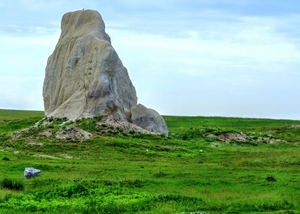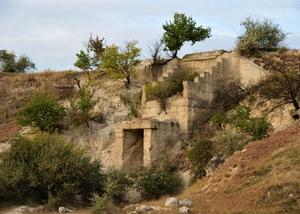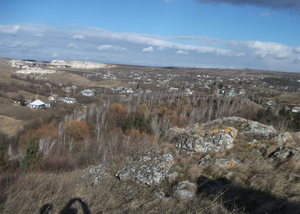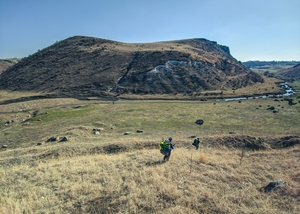Tourism
The Stâncile Prutului route represents a fascinating journey through the heart of the wild nature of the Republic of Moldova, which promises to offer you an unforgettable experience. Located in the north-east of the country, on the border with Ukraine, the Prut Rocks are impressive geological formations made up of calcareous rocks carved over millennia by the waters of the Prut River. This route offers the opportunity to explore spectacular landscapes, dense forests and rich biodiversity, while taking you along the banks of the Prut River, revealing some of the natural beauty of the Republic of Moldova. It is an ideal place for hiking, bird watching and connecting with nature in a scenic and wild environment.
The Râmb Rock
Among the 4 reefs in the so-called Râmbu area, the most representative is at the edge of the village, oval-shaped (oncoid). A cross has been erected on the rock of Râmb, which is called the "Patron Saint Cross".
The Butești Cave
The Butești Cave is a very picturesque and interesting cliff, about 2 km long, 60-125m wide. On the side of the cliff facing the village of Butești, there is a cave about 9 square meters deep and 2.5 meters high. This land is full of legends and history. The locals say that more than two centuries ago, these places were covered in forests. A huge snake-shaped rock, with a cave at its edge, also rested here.
Big Rock
The range of rocks near the village consists of 3 parts, of which the one that lies directly above the village and the valley of the river Camenca is called Stânca Mare (Big Rock), having a length of over 1000 m, width of 100 m and relative height of 40 m. The Camenca River hugs the reef from three streams. This natural fortress was inhabited by humans in the Stone Age.
The Dragon's tooths
At the border between the village of Gordinesti and the village of Volodeni there is a cliff 8 metres high and 20 metres long. The travellers who came to visit the landscape reserve "LA CASTEL" gave it the name "THE DRAGON'S TOOTH". From here you can enjoy a breathtaking view of the beauty of nature.
Old Stone Quarry
The old stone quarry of Balatina is located near the village, on the road Balatina-Lipovăț. Inside the site, from where stone was quarried between 1956 and 1991, a water basin was formed, which, due to the low rainfall, has also been drying up lately.
The Tomb of the Giant
The Giant's Tomb also has a legend. It is believed that giant men once lived here. The last of them is buried in this rock. The locals do not work this area, as legend has it that those who dared to work it either died suddenly or fell ill.
The Țuguieta Rock (Țugurlan)
The legend about the Țugueta rock says that "the children of the giant men who once lived on these places used to play, throwing massive pieces of rock at each other. A sharper piece of stone fell on this rock and because of the more pointed shape of the stone, the name of the rock Țuguieta arose.
The Mill Rock
The highest place in Brânzeni is called "Mill Rock". In the distant past, there was a water mill near the cliff on the right bank of the Racovăț River in the western part of the village. Not only the villagers came to the mill, but also people from neighboring villages. This is also where the name Stânca Morii comes from.
The "LA CASTEL" Gorge
A wonder of nature located above the Racovăț river valley, near the village of Gordinești is the landscape reserve "La Castel". This heritage of the Moldovan countryside is part of the picturesque chain of the Prut Cliffs (Sarmatian coral reefs)
One Hundred Mounds
The natural monument "One hundred mounds" is located between the villages of Cobani and Braniște. It represents a hilly landscape along the Prut and occupies six terraces near the Prut. It is the only place in Europe, where the sediments of the ancient seas, which once bathed this territory - the Tortonian and Sarmatian Seas - are concentrated.
The Rock of Evil Spirits
One could write a book about the Rock of Evil Spirits! It is probably the most mysterious rock in the north of the country, and still undiscovered to the end. Moreover, the villagers have blocked access to the depths of the cave, which is said to be endless.
"The Țiglău Cliff"
The cliff is bathed on two sides by the waters of the Ciuhur and shelters on the northern side a rather deep cave, called "Odaia" (Room) by the locals. Until 1978, the Ciuhur river used to meander past this cliff in its usual bed.
Căsoaia (Big House)
"Căsoaia" (Big House) is the name of one of the two caves on the left side of the "Cascade of Snakes". It is unique in the northern region of the country. The surroundings are fantastic, rich in flora and fauna, especially snakes.
The Lovers' Rock
"The Lovers' Rock" has a very interesting and tragic history. It is over 50 metres high and stands on the left bank of the Ciuhur River.
In the shade of the secular oak
Near the village of Moara Domnească there are the green historians of our land, secular oaks, which are more than 200-250 years old, some of them reaching 30-35 m in height and 2 m in diameter.
The "Royal Pond" - a jewel of the village
The Royal Pond is a beautiful place for rest and recreation. The river "Căldărușa" flows into it. In the past, the Pond was the largest in Moldova, with a surface of 400 ha. The villagers say that in 1852 the pond, which then had 300 ha, burst its banks, flooding a large part of the village's houses
Monument to the Romanian Heroes
The Monument to the Romanian Heroes fallen in the First World War was erected in the interwar period and for the first time installed in the Balatina Public Garden. This monument was erected at the initiative of Nicolae Balcescu, Head of the Cultural Centre in 1937, "in memory of the Heroes who sacrificed themselves for Country, Nation, Throne and Faith". (Inscription on the front of the monument).
The Church of the Assumption of the Mother of God in the village of Butești
The Church of the Assumption was built in 1842 and lasted 12 years, until 1854. It was built of stone in the shape of a ship. In 1957 it was restored by craftsmen from Chernivtsi. After 1972, during the persecution, it was closed by the communist regime, which was in power. In 1988, when the Holy Places were opened, the doors of the church in the village of Butești were reopened.
Mihai Viteazul Monument
We, the Cobanians had the honor 421 years ago, to have Michael the Brave with his soldiers in Cobani, who made a stop in the village. This fact led the authorities to honour the great prince and the founder of the unification of the principalities in 1601 with his bronze bust, placed in the park in front of the town hall.
The "Ciuhureanca" Seniors Group
And if you have exhausted your strength on the rocky lands of Horodistea, we invite you to an authentic artistic break. The senior ensemble "Ciuhureanca" is the village's calling card at various national and international festivals


 ro
ro
 ru
ru



















